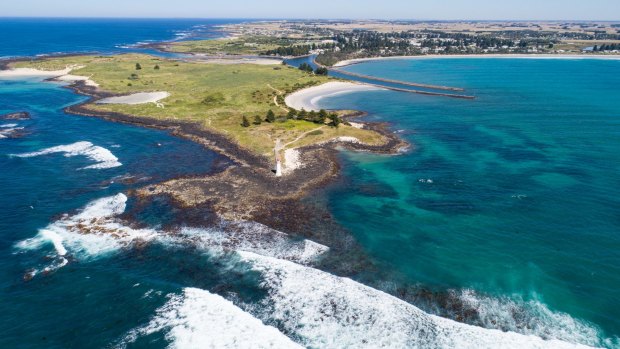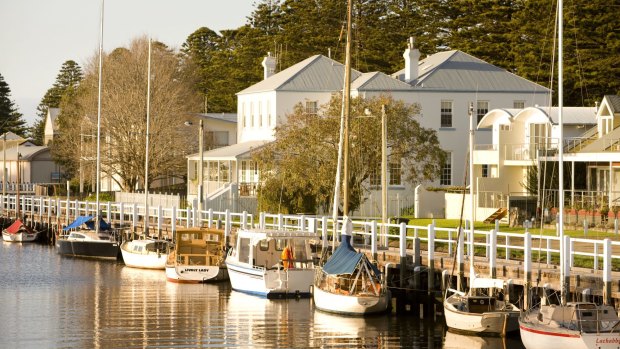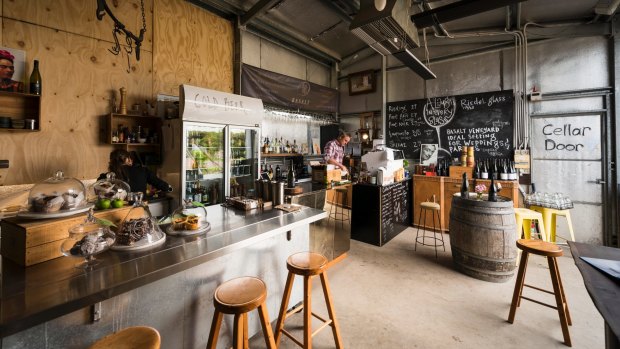This was published 3 years ago
Port Fairy, a travel guide: Avoid the Great Ocean Road crowds, and head to the seaside town most Victorians miss
By Belinda Jackson

The Port Fairy Lighthouse on the easternmost tip of Griffiths Island.Credit: iStock
"Oh Danny Boy, the pipes, the pipes are calling," rings out a voice that threaten to lift the rafters of the town hall.
It's the last competitor in the Australian Danny Boy competition at the annual Koroit Irish Festival, and there's not a spare seat in the hall. The audience – many who, like me, are among the 11 per cent of Australians who claim Irish heritage – is rapt.
Only five minutes from the coastline and 15 minutes from Port Fairy, little Koroit is far from the full car parks and bad coffee of Victoria's Great Ocean Road, and almost at the end of my run from Melbourne west to pretty Port Fairy, via the quiet, inland Hamilton Highway.

Charming: The seaside town of Port Fairy.Credit: Robert Blackburn
The bodhran, a drum of Irish origin, beats strong in this western corner of Victoria, which was the Shire of Belfast until the state's local government restructure in 1994. Its villages were settled predominantly by immigrants escaping Ireland's Great Famine in the 1840s and 1850s, when more than a million people starved to death.
It's the type of history that encourages you to head down country lanes to hear their voices: past a haunted Georgian pub, through crossroads of drystone walls and alongside black-soil fields of potatoes. A detour leads to the red-brick St Brigid's church in tiny Crossley, whose floors ring with the rap of Irish dancing classes every Saturday, and St Patricks' Day is big in this part of the world.
The professionally charming seaside town of Port Fairy was founded in 1835 as a whaling station named Belfast, and today, I walk the boardwalks lining its marina on the River Moyne – named for the Tipperary town where so many Irish settlers originated – where pleasure craft mix with working fishing vessels.

Basalt Winery, Port Fairy.Credit: Robert Blackburn
Bunking down for the night in the Great Ocean Road's most awarded accommodation, Drift House is a textbook definition of a boutique hotel. Until last year, it had just four rooms, but with the purchase of historic Belfast Cottage next door, it's a six-room, super-savvy little venture.
At Basalt Wines, in the potato-growing village of Killarney, owner-winemaker Shane Clancey traces Irish ancestors back to their landing in Port Fairy (then called Belfast) in 1839. "We're very adventurous, aren't we?" he says, pouring a biodynamic pinot noir into my glass. "We've gone a whole 5 km in nearly 200 years," he says of his local ancestors.
At his welcoming cellar door, I wolf down a dish of local smoked eel and Killarney potatoes. "It's our nod to our Irish ancestors and Budj Bim," says Shane, referring to the Aboriginal eel trap aquaculture system an hour west, which was listed as a UNESCO World Heritage site last year. He recommends a walk around nearby Tower Hill wildlife reserve to work off lunch and to connect with the other, older human story here, that of Gunditjmara country.
Designed for the lazy traveller, a circular drive takes you through Victoria's first state park, and a stepped walking path curves around its extinct volcano, said to have last erupted about 32,000 years ago. Wallabies and kangaroos nibble on the edges of the slow road and the Worn Gundidj Visitor Centre, built by renowned Victorian architect Robin Boyd, is patrolled by three emus. Those two cultures collide as the Irish village of Koroit, on its northern flank, took its name from the Koroitch Gundidj people, one of the original occupiers of this rich land.
The drive home the next day is a series of stops to fill the ever-present esky: firstly down a mud-clotted farm road in Killarney for a paper sack of fresh potatoes, still dusted in black volcanic soil. Further along the highway, I snap up fat, pungent heads of organic garlic from one highway stall, sweet apples from another, flicking my cash into metal honesty boxes.
Following the advice of Drift House's Colleen Guiney, my route back home to Melbourne deviates along empty coastal roads to find what's possibly the thirteenth Apostle, in a secret location that I'm not willing to share. And we whoop at the wild surf that smashes on the rock stack and claws at our feet, willing us to return. With luck, I will. I'll call on the luck of the Irish.
Belinda Jackson was a guest of Drift House and Visit Victoria.
See also: Get ready: 26 must-do highlights of Victoria
See also: The 10 best city walks to do right now
TRIP NOTES
MORE
STAY
Stays at the six-suite Drift House in Port Fairy cost from $445 a night, B&B. See drifthouse.com.au
GETTING THERE
Port Fairy is a 3½ hour drive from Melbourne via the Hamilton Highway Double that time if travelling via the Great Ocean Road.
DO
The Koroit Irish Festival offers free and ticketed events. See koroitirishfestival.com.au
Visit Tower Hill wildlife reserve's resident emus and walk its volcanic rim. Free entry. See towerhill.org.au
For music lovers, visit the Port Fairy Folk Festival. See portfairyfolkfestival.com
EAT
Basalt Wines' essential souvenir is a bottle of Shane Clancey's pinot noir, Killarney. See basaltwines.com
Sign up for the Traveller Deals newsletter
Get exclusive travel deals delivered straight to your inbox. Sign up now.